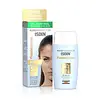What's inside
What's inside
 Key Ingredients
Key Ingredients

 Benefits
Benefits

 Concerns
Concerns

 Ingredients Side-by-side
Ingredients Side-by-side

Water
Skin ConditioningOctocrylene
UV AbsorberEthylhexyl Salicylate
UV AbsorberPropanediol
SolventButyl Methoxydibenzoylmethane
UV AbsorberPolymethyl Methacrylate
Dimethicone
EmollientPhenylbenzimidazole Sulfonic Acid
UV AbsorberPolysilicone-15
UV FilterPropylene Glycol Dicaprylate/Dicaprate
EmollientTromethamine
BufferingBis-Ethylhexyloxyphenol Methoxyphenyl Triazine
Skin ConditioningSilicon
Abrasive1,2-Hexanediol
Skin ConditioningPolysorbate 60
EmulsifyingPEG-7 Glyceryl Cocoate
EmulsifyingSodium Hyaluronate
HumectantTocopheryl Acetate
AntioxidantXanthan Gum
EmulsifyingCaprylyl Glycol
EmollientParfum
MaskingDisodium EDTA
PEG-4
HumectantTocopherol
AntioxidantTropolone
Skin ConditioningAscorbyl Palmitate
AntioxidantAscorbic Acid
AntioxidantCitric Acid
BufferingWater, Octocrylene, Ethylhexyl Salicylate, Propanediol, Butyl Methoxydibenzoylmethane, Polymethyl Methacrylate, Dimethicone, Phenylbenzimidazole Sulfonic Acid, Polysilicone-15, Propylene Glycol Dicaprylate/Dicaprate, Tromethamine, Bis-Ethylhexyloxyphenol Methoxyphenyl Triazine, Silicon, 1,2-Hexanediol, Polysorbate 60, PEG-7 Glyceryl Cocoate, Sodium Hyaluronate, Tocopheryl Acetate, Xanthan Gum, Caprylyl Glycol, Parfum, Disodium EDTA, PEG-4, Tocopherol, Tropolone, Ascorbyl Palmitate, Ascorbic Acid, Citric Acid
Water
Skin ConditioningDisodium Phenyl Dibenzimidazole Tetrasulfonate
UV AbsorberEthylhexyl Methoxycinnamate
UV AbsorberCI 77891
Cosmetic ColorantDicaprylyl Carbonate
EmollientDiisopropyl Adipate
EmollientPhenylbenzimidazole Sulfonic Acid
UV AbsorberBis-Ethylhexyloxyphenol Methoxyphenyl Triazine
Skin ConditioningNiacinamide
SmoothingDiethylamino Hydroxybenzoyl Hexyl Benzoate
UV FilterSodium Hydroxide
BufferingN-Vinyl Pyrrolidone
Caprylyl Methicone
Skin ConditioningPotassium Cetyl Phosphate
EmulsifyingAluminum Starch Octenylsuccinate
AbsorbentPhenoxyethanol
PreservativeHydrogenated Palm Glycerides
EmollientMethylene Bis-Benzotriazolyl Tetramethylbutylphenol
UV FilterGlycereth-26 Caprylate
EmollientDimethicone
EmollientTitanium Dioxide
Cosmetic ColorantCaprylyl Glycol
EmollientSodium Stearoyl Glutamate
CleansingSilicon
AbrasiveGlyceryl Stearate
EmollientCetyl Alcohol
EmollientCI 77492
Cosmetic ColorantMatrine
AntioxidantAesculus Hippocastanum Extract
AntioxidantHydrogen Dimethicone
CI 77499
Cosmetic ColorantAmmonium Glycyrrhizate
MaskingAluminum Hydroxide
EmollientPropylene Glycol
HumectantPanthenol
Skin ConditioningZinc Gluconate
Skin ConditioningHydrolyzed Hyaluronic Acid
HumectantCaffeine
Skin ConditioningBiotin
AntiseborrhoeicWater, Disodium Phenyl Dibenzimidazole Tetrasulfonate, Ethylhexyl Methoxycinnamate, CI 77891, Dicaprylyl Carbonate, Diisopropyl Adipate, Phenylbenzimidazole Sulfonic Acid, Bis-Ethylhexyloxyphenol Methoxyphenyl Triazine, Niacinamide, Diethylamino Hydroxybenzoyl Hexyl Benzoate, Sodium Hydroxide, N-Vinyl Pyrrolidone, Caprylyl Methicone, Potassium Cetyl Phosphate, Aluminum Starch Octenylsuccinate, Phenoxyethanol, Hydrogenated Palm Glycerides, Methylene Bis-Benzotriazolyl Tetramethylbutylphenol, Glycereth-26 Caprylate, Dimethicone, Titanium Dioxide, Caprylyl Glycol, Sodium Stearoyl Glutamate, Silicon, Glyceryl Stearate, Cetyl Alcohol, CI 77492, Matrine, Aesculus Hippocastanum Extract, Hydrogen Dimethicone, CI 77499, Ammonium Glycyrrhizate, Aluminum Hydroxide, Propylene Glycol, Panthenol, Zinc Gluconate, Hydrolyzed Hyaluronic Acid, Caffeine, Biotin
Ingredients Explained
These ingredients are found in both products.
Ingredients higher up in an ingredient list are typically present in a larger amount.
You might know this ingredient as Tinosorb S or Bemotrizinol. It is a UV filter that covers both UVA and UVB rays.
This ingredient has two peak UV absorption peaks ( 310 and 340 nm) and is able to absorb both UV-A and UV-B rays. This ingredient works by preventing UV rays from reaching and damaging your skin.
On top of that - it is highly photostable and helps prevent the photodegration of other sunscreen ingredients such as avobenzone.
Tinosorb S is allowed in the EU, Australia, and Asia. It is close to being approved by the FDA and we'll hopefully get this ingredient in the U.S. by late 2025.
Fun fact: Tinosorb S is the most effective UV absorber at maximum concentration (measured by SPF) permitted in the EU.
This ingredient is oil-soluble, so your oil-cleansers will take this right off at night.
Learn more about Bis-Ethylhexyloxyphenol Methoxyphenyl TriazineCaprylyl Glycol is a humectant and emollient, meaning it attracts and preserves moisture.
It is a common ingredient in many products, especially those designed to hydrate skin. The primary benefits are retaining moisture, skin softening, and promoting a healthy skin barrier.
Though Caprylyl Glycol is an alcohol derived from fatty acids, it is not the kind that can dry out skin.
This ingredient is also used as a preservative to extend the life of products. It has slight antimicrobial properties.
Learn more about Caprylyl GlycolDimethicone is a type of synthetic silicone created from natural materials such as quartz.
What it does:
Dimethicone comes in different viscosities:
Depending on the viscosity, dimethicone has different properties.
Ingredients lists don't always show which type is used, so we recommend reaching out to the brand if you have questions about the viscosity.
This ingredient is unlikely to cause irritation because it does not get absorbed into skin. However, people with silicone allergies should be careful about using this ingredient.
Note: Dimethicone may contribute to pilling. This is because it is not oil or water soluble, so pilling may occur when layered with products. When mixed with heavy oils in a formula, the outcome is also quite greasy.
Learn more about DimethiconeThis ingredient is more commonly known as Ensulizole, a chemical sunscreen ingredient.
Ensulizole mainly protects UV-B (290-340 nm) but offers a little UV-A (320-400 nm) protection. It is often paired with less photo-stable sunscreen ingredients due to its photo-stability.
Due to it being water-soluble, Ensulizole helps give sunscreens a light and non-oily texture.
Ensulizole is approved worldwide:
Learn more about Phenylbenzimidazole Sulfonic AcidSilicon is an abrasive as an INCI ingredient, meaning it has exfoliation properties.
If you see this ingredient in a tool, such as a brush, it is a material.
Water. It's the most common cosmetic ingredient of all. You'll usually see it at the top of ingredient lists, meaning that it makes up the largest part of the product.
So why is it so popular? Water most often acts as a solvent - this means that it helps dissolve other ingredients into the formulation.
You'll also recognize water as that liquid we all need to stay alive. If you see this, drink a glass of water. Stay hydrated!
Learn more about Water